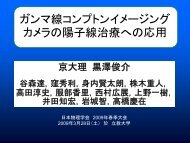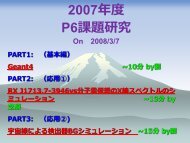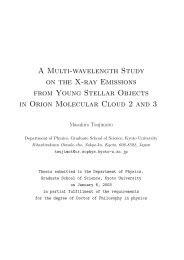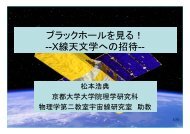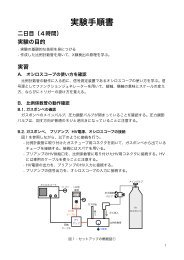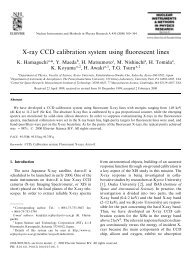¨28 CHAPTER 4. INSTRUMENTATIONsplit threshold (13 ADU; if <strong>the</strong> neighbor<strong>in</strong>g pixel has larger pixel value than <strong>the</strong> split threshold,it is regarded as <strong>the</strong> leak<strong>in</strong>g pixel). Table 4.2 gives <strong>the</strong> relationship <strong>of</strong> <strong>the</strong> ASCA/SIS and ACISgrad<strong>in</strong>g schemes. Usually, we regard <strong>the</strong> grades correspond<strong>in</strong>g to <strong>the</strong> ASCA/SIS grades 0, 2, 3, 4,and 6 as real events.£¢¡¥¤¦¢§¢¡¤ £¢¦Fig. 4.9.— Schematic for determ<strong>in</strong><strong>in</strong>g <strong>the</strong> ACIS grade. For example,an event that caused all pixels to exceed <strong>the</strong>ir threshold is grade 255.A s<strong>in</strong>gle pixel event is grade 0.£ ¡ §Table 4.2: Relation between <strong>the</strong> ASCA/SIS and ACIS gradesASCA/SIS gradeACIS grade0 . . . . . . . . . . . . . . . 01 . . . . . . . . . . . . . . . 1, 4, 5, 32, 33, 36, 37, 128, 129, 132, 133, 160, 161, 164, 1652 . . . . . . . . . . . . . . . 2, 34, 64, 65, 68, 69, 130, 1623/4 . . . . . . . . . . . . 8, 12, 16, 17, 48, 49, 136, 1405 . . . . . . . . . . . . . . . 3, 6, 9, 13, 20, 21, 35, 38, 40, 44, 52, 53, 96, 97, 100, 101, 131, 134,137, 141, 144, 145, 163, 166, 168, 172, 176, 177, 192, 193, 196, 1976 . . . . . . . . . . . . . . . 10, 11, 18, 22, 50, 54, 72, 76, 80, 81, 104, 108, 138, 139, 208, 2097 . . . . . . . . . . . . . . . All o<strong>the</strong>r gradesOperat<strong>in</strong>g modeTwo operat<strong>in</strong>g modes are available for ACIS. In this <strong>the</strong>sis, we only use <strong>the</strong> data <strong>of</strong> Timed Exposuremode with full frames and <strong>the</strong> frame time <strong>of</strong> 3.2 s.• Timed Exposure (TE) modeThe 1024 × 1024 active region <strong>of</strong> <strong>the</strong> CCD is exposed for a selected time <strong>in</strong>terval (frametime), <strong>the</strong>n <strong>the</strong> collected charge quickly (∼41 ms) transfers to <strong>the</strong> framestore region. For <strong>the</strong>entire CCD (full frames), <strong>the</strong> frame time is 3.2 s, which is <strong>the</strong> nom<strong>in</strong>al tim<strong>in</strong>g resolution <strong>of</strong>ACIS. In order to obta<strong>in</strong> better tim<strong>in</strong>g resolution or to avoid <strong>the</strong> pileup effect (see below),we can select subar<strong>ray</strong> mode; <strong>the</strong> active region is limited to 1/2, 1/4, or 1/8 subar<strong>ray</strong>, whichshortens <strong>the</strong> frame time to 0.4 s at <strong>the</strong> m<strong>in</strong>imum.
4.3. ACIS – ADVANCED CCD IMAGING SPECTROMETER 29• Cont<strong>in</strong>uous Clock<strong>in</strong>g (CC) modeCC mode achieves high tim<strong>in</strong>g resolution (3 ms) but has only one dimension <strong>of</strong> spatial resolution.Data are cont<strong>in</strong>uously clocked through <strong>the</strong> CCD and framestore to m<strong>in</strong>imize <strong>the</strong>readout time, with one-dimensional (1 × 1024 pixels) images.Telemetry formatThree telemetry formats are available as follows. Table 4.3 lists <strong>the</strong> operat<strong>in</strong>g modes, associatedformats, and approximate event rates at <strong>the</strong> telemetry saturation. The fa<strong>in</strong>t and very fa<strong>in</strong>t formatswere used for obs-BF and obs-A, respectively (§5.1).• GradedThis provides event positions <strong>in</strong> detector coord<strong>in</strong>ates, event amplitudes, arrival times, andevent grades.• Fa<strong>in</strong>tThis provides <strong>the</strong> same <strong>in</strong>formation as <strong>the</strong> Graded format o<strong>the</strong>r than <strong>the</strong> event grades. Alternatively,this supplies all <strong>in</strong>formation about 3 × 3 pixels around <strong>the</strong> event pixel. The biasmap (zero level <strong>of</strong> each pixel) is telemetered separately.• Very Fa<strong>in</strong>tThis is basically <strong>the</strong> same as <strong>the</strong> Fa<strong>in</strong>t format, but provides all <strong>in</strong>formation about 5 × 5 pixelsaround <strong>the</strong> event pixel. This format is used for <strong>the</strong> TE mode only and <strong>of</strong>fers <strong>the</strong> advantagefor m<strong>in</strong>imiz<strong>in</strong>g <strong>the</strong> background after ground process<strong>in</strong>g, but is limited for low-count sources(Table 4.3).Event pileupFor bright sources, two or more X-<strong>ray</strong> photons are <strong>of</strong>ten registered <strong>in</strong> a s<strong>in</strong>gle ACIS pixel with<strong>in</strong> onereadout cycle, which is called pileup. It causes an artificial spectral harden<strong>in</strong>g and underestimate<strong>of</strong> <strong>the</strong> X-<strong>ray</strong> counts. In fact, <strong>the</strong> brightest two sources <strong>in</strong> <strong>the</strong> <strong>ρ</strong> <strong>Ophiuchi</strong> cloud (A-2 and BF-64,see chapter 5) suffered <strong>the</strong> pileup effect. It can be reduced by select<strong>in</strong>g a proper observ<strong>in</strong>g mode(e.g., shorten <strong>the</strong> exposure time).
- Page 3: Contents1 Introduction 12 Review of
- Page 9 and 10: List of Figures2.1 The H-R diagram
- Page 11 and 12: LIST OF FIGURESix6.17 Light curves
- Page 13 and 14: List of Tables3.1 Multiwavelength s
- Page 15 and 16: Chapter 1IntroductionStar formation
- Page 17 and 18: Chapter 2Review of Low-mass Young S
- Page 19 and 20: 2.1. EVOLUTION OF LOW-MASS STARS 5w
- Page 21 and 22: 2.2. MOLECULAR CLOUDS 72.2 Molecula
- Page 23 and 24: 2.3. X-RAY OBSERVATIONS OF LOW-MASS
- Page 25 and 26: 2.3. X-RAY OBSERVATIONS OF LOW-MASS
- Page 27: 2.3. X-RAY OBSERVATIONS OF LOW-MASS
- Page 30 and 31: 16 CHAPTER 3. REVIEW OF THE ρ OPHI
- Page 32 and 33: 18 CHAPTER 3. REVIEW OF THE ρ OPHI
- Page 34 and 35: 20 CHAPTER 3. REVIEW OF THE ρ OPHI
- Page 36 and 37: 22 CHAPTER 4. INSTRUMENTATIONrespec
- Page 38 and 39: 24 CHAPTER 4. INSTRUMENTATIONangle
- Page 40 and 41: 26 CHAPTER 4. INSTRUMENTATIONThe AC
- Page 44 and 45: 30 CHAPTER 4. INSTRUMENTATIONTable
- Page 46 and 47: 32 CHAPTER 5. CHANDRA OBSERVATIONS
- Page 48 and 49: 34 CHAPTER 5. CHANDRA OBSERVATIONS
- Page 50 and 51: 36 CHAPTER 5. CHANDRA OBSERVATIONS
- Page 52 and 53: 38 CHAPTER 5. CHANDRA OBSERVATIONS
- Page 54 and 55: 40 CHAPTER 5. CHANDRA OBSERVATIONS
- Page 56 and 57: 42 CHAPTER 5. CHANDRA OBSERVATIONS
- Page 58 and 59: 44 CHAPTER 5. CHANDRA OBSERVATIONS
- Page 60 and 61: 46 CHAPTER 5. CHANDRA OBSERVATIONS
- Page 62 and 63: 48 CHAPTER 5. CHANDRA OBSERVATIONS
- Page 64 and 65: 50 CHAPTER 5. CHANDRA OBSERVATIONS
- Page 66 and 67: 52 CHAPTER 5. CHANDRA OBSERVATIONS
- Page 68 and 69: 54 CHAPTER 5. CHANDRA OBSERVATIONS
- Page 70 and 71: 56 CHAPTER 5. CHANDRA OBSERVATIONS
- Page 72 and 73: 58 CHAPTER 6. INDIVIDUAL SOURCEShig
- Page 74 and 75: 60 CHAPTER 6. INDIVIDUAL SOURCESres
- Page 76 and 77: 62 CHAPTER 6. INDIVIDUAL SOURCES6.2
- Page 78 and 79: 64 CHAPTER 6. INDIVIDUAL SOURCESfla
- Page 80 and 81: 66 CHAPTER 6. INDIVIDUAL SOURCESTab
- Page 82 and 83: 68 CHAPTER 6. INDIVIDUAL SOURCESUsi
- Page 84 and 85: 70 CHAPTER 6. INDIVIDUAL SOURCESlos
- Page 86 and 87: 72 CHAPTER 6. INDIVIDUAL SOURCES6.3
- Page 88 and 89: 74 CHAPTER 6. INDIVIDUAL SOURCESdes
- Page 90 and 91: 76 CHAPTER 6. INDIVIDUAL SOURCESocc
- Page 92 and 93:
78 CHAPTER 6. INDIVIDUAL SOURCES6.4
- Page 94 and 95:
80 CHAPTER 6. INDIVIDUAL SOURCES6.4
- Page 96 and 97:
82 CHAPTER 6. INDIVIDUAL SOURCES6.5
- Page 98 and 99:
84 CHAPTER 6. INDIVIDUAL SOURCES6.5
- Page 100 and 101:
86 CHAPTER 6. INDIVIDUAL SOURCEStha
- Page 102 and 103:
88 CHAPTER 6. INDIVIDUAL SOURCES1ke
- Page 104 and 105:
90 CHAPTER 6. INDIVIDUAL SOURCESThe
- Page 106 and 107:
92 CHAPTER 6. INDIVIDUAL SOURCESFig
- Page 108 and 109:
94 CHAPTER 6. INDIVIDUAL SOURCESPra
- Page 110 and 111:
96 CHAPTER 7. OVERALL FEATURE OF X-
- Page 112 and 113:
98 CHAPTER 7. OVERALL FEATURE OF X-
- Page 114 and 115:
100 CHAPTER 7. OVERALL FEATURE OF X
- Page 116 and 117:
102 CHAPTER 7. OVERALL FEATURE OF X
- Page 118 and 119:
104 CHAPTER 7. OVERALL FEATURE OF X
- Page 121 and 122:
Chapter 8Systematic Study of YSO Fl
- Page 123 and 124:
8.2. CORRELATION BETWEEN THE FLARE
- Page 125 and 126:
8.3. MAGNETIC RECONNECTION MODEL 11
- Page 127 and 128:
8.5. EFFECT OF THE QUIESCENT X-RAYS
- Page 129 and 130:
8.6. EVOLUTION OF YSOS AND THEIR FL
- Page 131 and 132:
Chapter 9ConclusionWe summarize the
- Page 133 and 134:
Appendix AFlare Light CurvesFig. A.
- Page 135 and 136:
Fig.A.2 (Continued)121
- Page 137:
Fig. A.4.— Same as Figure A.1, bu
- Page 140 and 141:
126 APPENDIX B. PHYSICAL PARAMETERS
- Page 142 and 143:
128 APPENDIX B. PHYSICAL PARAMETERS
- Page 145 and 146:
Appendix CModeling of the FlareIn t
- Page 147 and 148:
C.2. PREDICTED CORRELATIONS BETWEEN
- Page 149 and 150:
BibliographyAgeorges, N., Eckart, A
- Page 151 and 152:
BIBLIOGRAPHY 137Feigelson, E. D., &
- Page 153 and 154:
BIBLIOGRAPHY 139Johnstone, D., Wils
- Page 155 and 156:
BIBLIOGRAPHY 141Rutledge, R. E., Ba
- Page 157:
BIBLIOGRAPHY 143Yokoyama, T. & Shib






